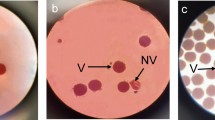Abstract
Sex allocation theory predicts that: (1) resources allocated to androecium should decrease with an increase in selfing, (2) a decrease in androecium biomass should be accompanied by an increase in the biomass of pistils, and (3) a decrease in androecium biomass should be coupled with a decrease in flower size, specifically corolla biomass. Another predicted change in reproductive traits associated with variation in selfing concerns seed to ovule ratios, but does not directly stem from sex allocation theory. It has been postulated that seed to ovule ratios should be positively correlated with the amount of selfing. These predictions were tested for six accessions of pigeonpea,Cajanus cajan L., that differed in selfing rates. The results were remarkably in accordance with the predictions. We conclude that sex allocation theory provides a powerful tool to understand the evolution of many reproductive traits in plants.
Similar content being viewed by others
References
El Baradi, T. A., 1978: Pulses. — Trop. Agri. Abstr.9: 23.
Bawa, K. S., 1980: Evolution of dioecy in flowering plants. — Ann. Rev. Ecol. Syst.11: 15–39.
-Buckley, D. P., 1989: Seed: ovule ratios, selective abortion and mating systems inLeguminosae. — InStintson, C. H.,Zarucchi, J. L., (Eds.): Advances in legume biology. — Missouri Bot. Gard. Monogr. Syst. Bot. (in press).
—,Webb, C. J., 1983: Floral variation and sexual differentiation inMuntingia calabura (Elaeocarpaceae), a species with hermaphrodite flowers. — Evolution37: 1271–1282.
—, —, 1984: Flower, fruit and seed abortion in tropical forest trees: implications for the evolution of paternal and maternal reproductive patterns. — Amer. J. Bot.71: 736–751.
Bell, G., 1985: On the function of flowers. — Proc. Roy. Soc. London B224: 223–265.
Bubar, J. S., 1956: An association between variability in ovule development within ovaries and self-incompatibility inLotus (Leguminosae). — Canad. J. Bot.36: 65–72.
Charlesworth, D., Charlesworth, B., 1981: Allocation of resources to male and female function in hermaphrodites. — Biol. J. Linn. Soc.15: 57–74.
Charnov, E. L., 1982: The theory of sex allocation. — Princeton, New Jersey: Princeton University Press.
- 1987: On sex allocation and selfing in higher plants. — Evol. Ecology1 (in press).
Cruden, W. R., Lyon, D. L., 1985: Patterns of biomass allocation to male and female functions in plants with different mating systems. — Oecologia66: 299–306.
Darwin, C., 1892: The different forms of flowers on plants of the same species. 2nd edn. — London: John Murray.
Hamilton, W. D., 1967: Extraordinary sex ratios. — Science156: 477–488.
Harding, J., Makinen, C. B., Elliot, M. H., 1974: Genetics ofLupinus 7. Outcrossing, autofertility, and variability in natural populations of thenanus group. — Taxon23: 729–738.
Lee, T. D., 1984: Patterns of fruit maturation: a gametophyte competition hypothesis. — Amer. Naturalist123: 427–432.
Lewis, D., 1956: Genetics and plant breeding. — Brookhaven Symp. Biol.9: 89–100.
Lloyd, D. G., 1965: Evolution of self-compatibility and racial differentiation inLeavenworthia (Cruciferae). — Contr. Gray Herb.195: 3–134.
—, 1984: Gender allocations in outcrossing cosexual plants. — InDirzo, R., Sarukhan, J., (Eds.): Perspectives in plant population ecology, pp. 277–300. — Sunderland, Mass.: Sinauer.
Lovett-Doust, J., Cavers, P. B., 1982: Biomass allocation in hermaphrodite flowers. — Canad. J. Bot.60: 2530–2534.
McKone, M. J., 1987: Sex allocation and outcrossing rate: a test of theoretical predictions using bromegrasses (Bromus). — Evolution41: 591–598.
Ornduff, R., 1969: Reproductive biology in relation to systematics. — Taxon18: 121–244.
Prasad, S., Prakash, R., Haque, M. J., 1977: Floral biology of pigeonpea. — Tropical Grain Legume Bull.7: 12.
Ross, M. D., 1984: Frequency dependent selection in hermaphrodites: the rule rather than the exception. — Biol. J. Linn. Soc.23: 145–155.
Schoen, D. J., 1982a: Male reproductive effort and breeding system in an hermaphroditic plant. — Oecologia53: 255–257.
—, 1982b: The breeding system ofGilia achilleifolia: variation in floral characteristics and outcrossing rate. — Evolution36: 352–360.
Sokal, R. R., Rohlf, F. J., 1981: Biometry. — San Francisco: Freeman.
Author information
Authors and Affiliations
Rights and permissions
About this article
Cite this article
Cumaraswamy, A., Bawa, K.S. Sex allocation and mating systems in pigeonpea,Cajanus cajan (Fabaceae). Pl Syst Evol 168, 59–69 (1989). https://doi.org/10.1007/BF00936107
Received:
Issue Date:
DOI: https://doi.org/10.1007/BF00936107




